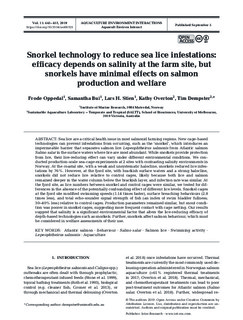| dc.description.abstract | Sea lice are a critical health issue in most salmonid farming regions. New cage-based technologies can prevent infestations from occurring, such as the ‘snorkel’, which introduces an impermeable barrier that separates salmon lice Lepeophtheirus salmonis from Atlantic salmon Salmo salar in the surface waters where lice are most abundant. While snorkels provide protection from lice, their lice-reducing effect can vary under different environmental conditions. We conducted production-scale sea-cage experiments at 2 sites with contrasting salinity environments in Norway. At the coastal site, with a weak and unsystematic halocline, snorkels reduced lice infestations by 76%. However, at the fjord site, with brackish surface waters and a strong halocline, snorkels did not reduce lice relative to control cages, likely because both lice and salmon remained deeper in the water column below the brackish layer, and infection rate was similar. At the fjord site, as lice numbers between snorkel and control cages were similar, we tested for differences in the absence of the potentially confounding effect of different lice levels. Snorkel cages at the fjord site modified swimming speeds (1.14 times faster), surface breaching behaviours (2.8 times less), and total echo-sounder signal strength of fish (an index of swim bladder fullness; 30-40% less) relative to control cages. Production parameters remained similar, but snout condition was poorer in snorkel cages, suggesting more frequent contact with cage netting. Our results suggest that salinity is a significant environmental factor that alters the lice-reducing efficacy of depth-based technologies such as snorkels. Further, snorkels affect salmon behaviour, which must be considered in welfare assessments of their use. | nb_NO |
